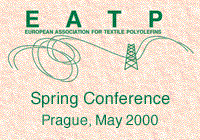 THE POLISH TEXTILE AND MAN — MADE FIBRES INDUSTRYAlojzy Urbanowski, Institute of Chemical Fibres, Lódz, PolandGENERAL INFORMATIONIn my presentation during the last EATP Spring Conference in Praia de Rocha Portugal some information on Poland’s economy were included. I would like now to complement that information with data relating to 1999 and 2000.
Fig. 1. Poland’s Annual GDP Growth 1991 - 1999 (as % to previous year).
Fig. 2. Poland’s Industrial Output 1991 - 1999 (as % to previous year).
Unemployment rose from 11 % in 1998 to 13 % in 1999. GDP per capita was 8430 $ (march 2000) Foreign direct investment is presented in Table 1.
Poland is seen as an attractive destination for foreign investors. The American Consulting company AT Kearney has recently published a report concerning world wide foreign investment confidence. The report contained the graph of Figure 4.
Fig. 4. Foreign investors’ confidence index, January 2000 World - wide interest in Poland is quickly increasing. The country moved last year from eight to fifth place among the countries most attractive for FDI. Central and Eastern Europe is still seen as a high risk region but it does better than other regions in terms of profits actually achieved. POLAND’S TEXTILE INDUSTRYThe light industry is divided in three main segments:
Garment makers in Poland enjoyed in the last years an extensive cooperation with Western Europe mostly in the framework of commission sewing. The cooperation is recently turning step - wise toward a license formula. The leather industry stands under increasing pressure of massive imports. The textile industry played an important role in Poland is economy, which is illustrated with following data.
Table 3 and 4 present the foreign exchange in fibrous materials and products.
Exports are higher than imports with prevailing garments. Region - wise the European Union is most important. In 1989 and the first 90ties Poland’s economy and industry suffered a drastic decrease. The recession in textile industry was deeper than in the remaining industry reaching 60% of the original output. In 1992 the industry begun to recover, however, much slower than the downswing in 1990/91. Disappointingly the production figures for 1998 and 1999 again show a negative trend which is illustrated with Figure 5.
Fig. 5. Output of Poland’s Textile and Garment Industry. THE MAN — MADE FIBER INDUSTRYThe consumption of fibrous raw materials in Poland in the two last decades reflects distinctly the enormous changes in the textile industry, overall economy and market conditions which occurred at the end of the 80ties and in the 90ties. The mill consumption of both natural and man-made fibres in Poland over a longer period is presented in Figure Table 5.
The production of man - made fibres is presented in Table 6.
Some capacities were shut down and will never resume production. From the eight man - made fibres plants in the 80ties only three remain now in operation. This is illustrated with Table 7.
Imports, exports domestic production and mill consumption in 1998 are presented in Table 8.
POLYPROPYLENE (PP) FIBRESIn the preceding section PP fibres are not included. The production of PP fibres and the market were presented in the March issue of Polynews in the article "Polypropylene Fibres in Poland". Some more information was contained in my presentation at EATP Spring Conference in May 1999 in Praia da Rocha, Portugal: "The Polish PP Market and Business Opportunities". The production of various PP fibres in Poland in 1998 and 1999 is given in Table 9.
Contrary to other man - made fibres the product of PP is showing a rather increasing tendency particularly is multifilaments and spun bonds. The production is being developed at small private companies. No major producer of PP fibres exists in Poland. The market is developing. Technical textiles, the main consumer of PP fibres is the only sector in the textile industry with a positive development.
|
||||||||||||||||||||||||||||||||||||||||||||||||||||||||||||||||||||||||||||||||||||||||||||||||||||||||||||||||||||||||||||||||||||||||||||||||||||||||||||||||||||||||||||||||||||||||||||||||||||||||||||||||||||||||||||||||||||||||||||
This article is published on NF New Fibres, see the contents.


 Fig. 3. Inflation 1991 - 1999 (as % to previous year).
Fig. 3. Inflation 1991 - 1999 (as % to previous year).
